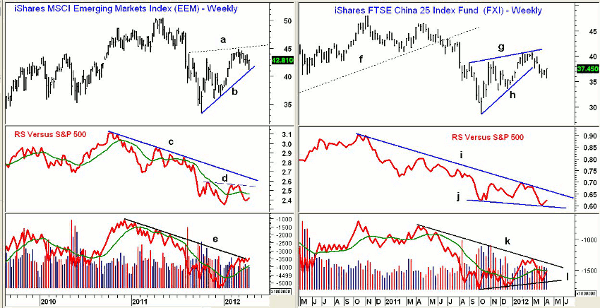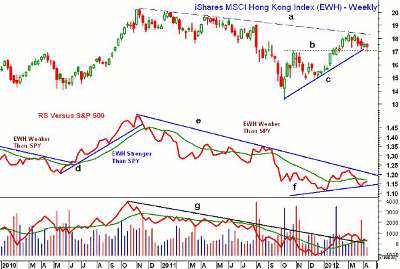Despite disappointing GDP data from China, emerging markets may still surprise to the upside in the coming months, and investors should be on the lookout for new buying opportunities in select ETFs.
The US stock market put in another strong performance on Thursday, and the emerging markets were especially strong. Rumors that China’s first-quarter GDP would come in at 9%, well above the 8.3% estimate, spurred some buying. This helped the iShares FTSE China 25 Index Fund (FXI) record a 3.5% gain for the day.
The actual report of 8.1% is likely to disappoint, however, and in early-Friday trading, the stock index futures were trading lower. The rally over the past two days has relieved the short-term oversold status, and the McClellan Oscillator (a short-term Advance/Decline (A/D) indicator) has risen from -355 to -62.
Many analysts seem to be basing their outlook for the US stock market on the health of the Chinese economy. Only a hard or soft landing seems to be separating the bears from the bulls, but I would be very surprised if China’s leaders let the economy collapse after working so hard to build it.
So what role should China and the emerging markets play in your portfolio? Using the relative performance analysis, which compares the S&P 500 to the overseas markets, can be very helpful in identifying the stronger and weaker performers. The current weekly analysis still favors the S&P 500, or the Spyder Trust (SPY), but this could change in the next few weeks.
Chart Analysis: The weekly chart of the iShares MSCI Emerging Markets Index Fund (EEM) shows that the uptrend from the late-2011 lows, line b, was tested this week. There is still key resistance in the $44.50-$45 area, line a.
- The fact that the uptrend from the 2009 lows was broken last May suggests that a bear flag (lines a and b) could be forming
- A weekly close below the $40 level should complete the flag formation with Fibonacci price projections in the $30 area
- Weekly relative performance, or RS analysis, is trying to turn up and could be forming a bottom
- A move back above its weighted moving average (WMA) and resistance at line d would suggest that EEM is starting to outperform the S&P 500
- On-balance volume (OBV) is positive and well above its rising weighted moving average. It is now trying to break its weekly downtrend, line e
- Daily OBV (not shown) is trying to bottom but has not yet started a new uptrend
The iShares FTSE China 25 Index Fund (FXI) broke its uptrend from the 2008 lows (line e) in June 2011. Therefore, the recent rebound appears to be a flag formation that was completed four weeks ago when support at line h was broken.
- FXI has been trying to stabilize over the past three weeks, as support at $35.55 has been holding
- There is further support now at $33.30 with the 127.2% Fibonacci price target from the flag formation (lines g and h) in the $26.50 area
- RS analysis started a new downtrend in late 2010 and has recently made lower lows, line j. It needs to move through its downtrend, line i, and surpass the early-2012 highs to bottom out
- Weekly OBV has turned up over the past few weeks, line l, but it is still below its weighted moving average. A move through the downtrend in the OBV (line k) would be a positive sign
- FXI closed Thursday just below resistance at $37.60 with stronger resistance in the $38.50-$39 area
NEXT: Another Key Emerging ETF to Watch
|pagebreak|
The daily chart of the iShares MSCI Hong Kong Index Fund (EWH) closed above the neckline (line e) of its reverse head-and-shoulders (H&S) formation on January 19 and rallied up to resistance and the weekly downtrend (line a) in the $18.40 area.
- EWH broke its uptrend at $17.16 (line c) this week, but after Thursday’s rally, it is now trading back above it. This support also corresponds to the October highs, line b
- A drop below $16.75 would be more negative
- The RS analysis over the past few years has done a good job identifying those times when EWH has been stronger or weaker than the S&P 500, as measured by SPY
- The break of the downtrend in June 2010 signaled that EWH was stronger than SPY
- This uptrend, line c, was broken in November 2010, signaling that EWH was going to begin lagging the S&P 500
- This downtrend, line d, is still intact. The RS line is trying to form higher lows, line e, and a move above its weighted moving average and the prior peak will turn the RS positive
- Weekly OBV is at a critical juncture, as it broke its downtrend, line f, in early February and is now testing its weighted moving average. A sharply higher close next week on high volume could turn the OBV bullish
What It Means: From a technical standpoint, there are no strong signs to prompt new buying in the emerging markets or in these China and Hong Kong ETFs. For those who are already long, fairly tight stops are recommended, as these funds still carry a fair amount of downside risk.
The sentiment picture remains quite negative, and a recent MoneyShow sentiment survey indicated that only 5.4% were committing new funds to the emerging markets, as opposed to the almost 32% who were moving into large-cap stocks. Historically, high levels of bearish sentiment have set up some good buying opportunities.
How to Profit: There are no new recommendations for now in the emerging market ETFs, but these should be monitored closely over the next few months in case new buying opportunities are presented.




















